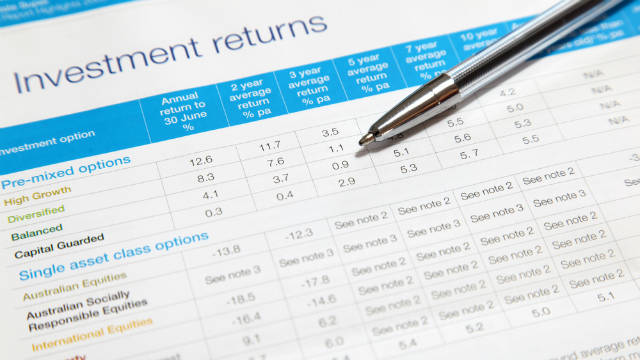7 things to check on your superannuation statement

Your superannuation statement is a very important document. Be sure to take a good look at these seven things.
When you get your superannuation statement in the mail or your inbox it’s important to take more than a cursory glance at your balance and file it away. There are a number of things that you should look at to make sure you’re on the right track to achieve your dream retirement.
Here are the top seven things you should check.
1. Your balance
How much do you have in your super and how does that compare to how much you should have?
The SuperGuru website has a handy calculator called the ‘Super Balance Detective’. You enter the year you were born and it will show you how much you should have in superannuation now to reach the ASFA Comfortable Standard balance by age 67.
The table below shows how much you should have based on various ages.
How much super you should have to reach a comfortable retirement
← Mobile/tablet users, scroll sideways to view full table →
| Age | How much you should have |
|---|---|
| 25 | $17,000 |
| 35 | $93,000 |
| 45 | $195,000 |
| 55 | $330,000 |
| 65 | $503,000 |
Source: SuperGuru Super Balance Detective calculator. The reported figure is the approximate amount a person should have in superannuation now to reach the ASFA Comfortable Standard balance by age 67.
If you find that you are behind where you should be it may be worth exploring ways to boost your super.
2. The transaction summary
The next thing to check are the transactions. Is your boss making the contributions and are they correct? You can use the MoneySmart ‘Employer contributions calculator’ to work out how much super you should be getting from your employer. Also, if you are salary sacrificing make sure that money has been going in.
It’s worth noting that employers don’t have to make contributions to super each payday so don’t get thrown off if you don’t see payments each fortnight or month.
According to the ATO, employers just have to make payments at least four times a year, by the quarterly due dates which are outlined in the table below.
Super payment due dates
← Mobile/tablet users, scroll sideways to view full table →
| Period | Due date |
|---|---|
| 1 July – 30 September | 28 October |
| 1 October – 31 December | 28 January |
| 1 January – 31 March | 28 April |
| 1 April – 30 June | 28 July |
Source: ato.gov.au
If you think you have not been paid the right amount of super, have a chat to your employer to see if you can work it out. If you’re not happy with their response you can get in touch with the ATO to help you resolve the issue.

3. The fund’s performance
It’s important to look at how your fund has performed.
A number of factors come into play here including your asset mix. That is whether you’re in a conservative, balanced or growth option.
Most members would be sitting in a balanced fund.
When you are looking at returns it’s important to take a long-term view. Given the unprecedented investment market volatility and economic uncertainty it’s not surprising that many funds produced a negative result over the past 12 months, but have performed better over three and five years.
Average Superannuation Net Returns
← Mobile/tablet users, scroll sideways to view full table →
| Profile | Growth asset allocation | 1-year return | 3-year return | 5-year return | 7-year return |
|---|---|---|---|---|---|
| Cash | 0% | 0.65% | 1.11% | 1.30% | 1.64% |
| Conservative | 20-39.99% | 0.52% | 3.48% | 3.73% | 4.50% |
| Moderate | 40-59.99% | -0.80% | 3.52% | 3.81% | 5.54% |
| Balanced | 60-79.99% | -0.47% | 4.97% | 5.40% | 7.06% |
| Growth | 80-100% | -1.28% | 5.37% | 5.91% | 7.92% |
Source: www.canstar.com.au. Based on superannuation investment options on Canstar’s database available for a 30 year old. Returns are net of administration, investment and performance fees and tax. Returns effective to 30 June 2020. Past performance is not a reliable indicator of future performance.
Be sure to look at how the fund compares with other funds that invest in similar assets. The table above shows the average super returns of various asset mixes which will give you an idea of how your fund has performed relative to its peers.
4. The fees
Make sure you take a look at the fees to ensure they aren’t too high. High fees can have an impact on your super balance at retirement.
Many experts say ideally your fees should be about 1% of your balance. To work out your fees expressed as a percentage, take the total fee amount, divide it by your balance and multiply it by 100. So let’s say you paid $1,500 in fees and your balance is $120,000 your fees come to 1.25%. That is higher than the average amount for that balance (see table below).
Average Superannuation Fees (as a percent of balance)
← Mobile/tablet users, scroll sideways to view full table →
| Balance | Average Fee |
|---|---|
| $20,000 | 1.40% |
| $40,000 | 1.21% |
| $60,000 | 1.14% |
| $80,000 | 1.11% |
| $100,000 | 1.09% |
| $120,000 | 1.07% |
| $140,000 | 1.06% |
Source: www.canstar.com.au. Based on superannuation investment options on Canstar’s database as at 30 June 2020. For lifestage products an age of 30 years is assumed.
5. Your insurance cover
Many of us have insurance through our super. As well as taking a look at how much the cover is costing you make sure you think about whether the level of cover suits your current circumstances.
For example, consider whether life changes mean you should adjust your levels of life or TPD insurance.
6. How your money is invested
Take a look at the asset mix and make sure it is still right for your needs.
A ‘balanced’ fund will generally put your money into a mix of shares, fixed income and other investments, such as infrastructure.
A ‘growth’ fund will be more heavily weighted towards share investments, which may mean returns will be more volatile from year to year, but growth funds tend to deliver bigger returns over time.
If you’re not sure about the best option for you consider getting advice from your super fund or an independent adviser.
7. Your beneficiaries
Check who is listed as your beneficiaries, that is who you want to get your super and insurance if you die. Make sure that is still correct.
For example, if it is a partner who you have since split with you may want to change it.
It’s important to note though that to make sure your super goes to the person (or people) you want you should have a binding nomination.
Compare Superannuation with Canstar
The table below displays some of the superannuation funds currently available on Canstar’s database for Australians aged 30 to 39 with a super balance of up to $55,000. The results shown are sorted by Star Rating (highest to lowest) and then by 5 year return (highest to lowest). Performance figures shown reflect net investment performance, i.e. net of investment tax, investment management fees and the applicable administration fees based on an account balance of $50,000. To learn more about performance information, click here. Consider the Target Market Determination (TMD) before making a purchase decision. Contact the product issuer directly for a copy of the TMD. Use Canstar’s superannuation comparison selector to view a wider range of super funds. Canstar may earn a fee for referrals.
 Online rollover
Online rollover
 Online application
Online application
 Online rollover
Online rollover
 Online application
Online application
 Online rollover
Online rollover
 Online application
Online application
 Online rollover
Online rollover
 Online application
Online application
- Performance, fee and other information displayed in the table has been updated from time to time since the rating date and may not reflect the products as rated.
- The performance and fee information shown in the table is for the investment option used by Canstar in rating of the superannuation product.
- Performance information shown is for the historical periods up to 31/05/2024 and investment options noted in the table information.
- Performance figures shown reflect net investment performance, i.e. net of investment tax, investment management fees and the applicable administration fees based on an account balance of $50,000. To learn more about performance information, click here.
- Performance data may not be available for some products. This is indicated in the tables by a note referring the user to the product provider, or by no performance information being shown.
- Please note that all information about performance returns is historical. Past performance should not be relied upon as an indicator of future performance; unit prices and the value of your investment may fall as well as rise.
- Any advice on this page is general and has not taken into account your objectives, financial situation or needs. Consider whether this general financial advice is right for your personal circumstances. You may need financial advice from a qualified adviser. Canstar is not providing a recommendation for your individual circumstances. See our Detailed Disclosure.
- Not all superannuation funds in the market are listed, and the list above may not include all features relevant to you. Canstar is not providing a recommendation for your individual circumstances.
- Canstar may earn a fee for referrals from its website tables, and from Sponsorship or Promotion of certain products. Fees payable by product providers for referrals and Sponsorship or Promotion may vary between providers, website position, and revenue model. Sponsorship or Promotion fees may be higher than referral fees. Sponsored or Promotion products are clearly disclosed as such on website pages. They may appear in a number of areas of the website such as in comparison tables, on hub pages and in articles. Sponsored or Promotion products may be displayed in a fixed position in a table, regardless of the product’s rating, price or other attributes. The table position of a Sponsored or Promoted product does not indicate any ranking or rating by Canstar. For more information please see How We Get Paid.
- Click here for additional important notes and liability disclaimer.
Performance and Investment Allocation Differences
- Fee, performance and asset allocation information shown in the table above have been determined according to the investment profile in the Canstar Superannuation Star Ratings methodology.
- Some providers use different age groups for their investment profiles which may result in you being offered or being eligible for a different product to what is displayed in the table. See here for more details.
- Australian Retirement Trust Super Savings’ allocation of funds for investors aged 55-99 differ from Canstar’s methodology – see details here.
- The Australian Retirement Trust Super Savings (formerly Sunsuper for Life) product may appear in the table multiple times. While you will not be offered any single investment option, this is to take into account the different combinations of investment options Australian Retirement Trust may apply to your account based on your age. For more detail in relation to the Australian Retirement Trust (formerly SunSuper for Life) product please refer to the PDS issued by Australian Retirement Trust for this product.
- Investment profiles applied initially may change over time in line with an investor’s age. See the provider’s Product Disclosure Statement and TMD and in particular applicable age groups for more information about how providers determine their investment profiles.
Cover image source: GalacticDreamer/Shutterstock.com
This article was reviewed by our Editorial Campaigns Manager Maria Bekiaris before it was updated, as part of our fact-checking process.
Try our Superannuation comparison tool to instantly compare Canstar expert rated options.






